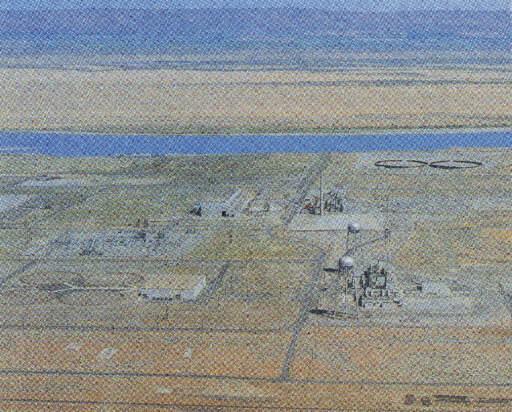1. A Curse on the People of Hanford
Jan. 1, 2013
Chapter 1: The United States
Part 1: Hanford's Hidden Past
Part 1: Hanford's Hidden Past
In 1942, under the code name of The Manhattan Project, development of the atomic bomb began in America, heralding the dawn of the nuclear era. Three years later, the bombings of the Japanese cities of Hiroshima and Nagasaki marked the beginning of the desperate race for nuclear supremacy. Prominent in the American effort in the arms race over the next forty-five years was the town of Hanford in Washington State. However, it is only recently that the residents of Hanford have begun to uncover the hidden past of the nuclear weapons facility with which they coexisted all those years.
1. A Curse on the People of Hanford
Despite driving into the hills and using roads long fallen into disuse, we appeared to have missed the turning for the Hanford nuclear complex. Eventually, we decided to rent a small plane with the idea that we might have more luck from the air.
The scene below us changed from one of green fields to a vast expanse of rock and desert. Low, rolling hills revealed a desolate plain of almost five hundred square miles stretching away into the distance. Along the banks of a river, smokestacks and clusters of buildings came into view—in all, we counted nine reactors. The area was surrounded on all four sides by steep mountain ranges. This had been the reason why Hanford was chosen as one of the first sites for the development of nuclear weapons, the others being in Oak Ridge, Tennessee, and in Los Alamos, New Mexico.
Originally a town of twelve hundred people, Hanford was commandeered by the U.S. Army in 1943, following which work was begun on the construction of a plutonium manufacturing facility. All this took place under a thick veil of secrecy.
At the western end of the complex we could see the B reactors. The two towers shone brightly in the sunlight, and around their bases nestled a collection of gray buildings. "Those are the reactors that produced the plutonium for 'Fatman,' the Nagasaki bomb," our pilot, farmer Tom Bailie, pointed out. The uranium used in the process was imported mainly from Canada. In 1944 these reactors reached critical mass; the resulting plutonium was then transported to Los Alamos, where Fatman was put together. "People say that Nagasaki's most terrible nightmares were born here," commented Bailie.
Hanford's role did not finish with Fatman. After the end of the Second World War, the advent of the Cold War increased the demand for plutonium, and the complex expanded rapidly to become the mainstay of America's nuclear program. In 1968, when the supply of plutonium at Hanford was judged to be sufficient, the B reactors stopped producing Plutonium and the others were gradually shut down. The remaining plants, the N reactors, were finally taken out of operation in 1986.
No smoke, nothing—there wasn't a single sign of human habitation. The Hanford complex is now nothing more than a hideous monument to the nuclear era. Our pilot, however, did not agree with this observation. "A monument?" he snorted. "No way. This place is a curse on us." With that he started to tell us about the radioactive contamination which had only come to light three years previously, and which was causing panic among the local residents.
In the thirteen-year period from 1944 when the B reactors first went into operation, 530,000 curies of iodine-131 were released into the atmosphere. Buried in secret files, this fact was only made public in 1986, along with the equally shocking revelation that in 1949, as an experiment, radioactive material was deliberately released into the surrounding area.
Six years of hard work on the part of one reporter lie behind the disclosure of these facts. Karen Steele, environment and special projects reporter for the Spokesman Review of Spokane, first investigated the situation at Hanford in 1984. She had just published an article pointing out the illegality of the construction of a nuclear power plant for a private company within the complex, when she received a phone call. The caller told her there were issues more important at stake in Hanford than the mere misuse of funds. The woman, a worker at the plant, told her that, since Reagan had come to power, there had been a sudden increase in the production of plutonium for military use. She added that the health of employees was being ignored, and that the disappearance of over twenty pounds of plutonium, ample for a bomb, was being investigated by the FBI.
From this unexpected beginning, Steele's interest in Hanford increased to include not only incidents in the complex itself, but also those in the surrounding areas. Women told her about the prevalence of thyroid diseases and cancer in the area; farmers testified that, on the nearby farms, it was not unusual for cows and goats to be born with deformities. Steele concluded that the nuclear complex must be giving off some kind of harmful substance.
At the same time, environmental protection groups such as the Hanford Education Action League (HEAL) were conducting their own inquiries into Hanford. The groups had been negotiating with the Department of Energy (DOE) ever since 1984 for the release of relevant documents concerning the nuclear complex. In response to numerous requests from Steele's newspaper, HEAL, and the Environmental Policy Institute of Washington D.C., the DOE decided to release the material in February 1986. The documents contained the shocking information that over a period of thirteen years during the 1940s and 1950s, a total of 530,000 curies of iodine-131 had been released into the atmosphere; an amount certain to cause serious contamination.
Steele got the story on the front page of the Spokesman Review, and larger papers all over the United States soon followed up with their own articles about radioactive contamination in Hanford.
Steele and the league members next focused their attention on a single sentence buried in the mass of papers which seemed to indicate that an important experiment, codenamed Green Run, was carried out in 1949. For reasons of national security, the DOE refused access to material giving further details about the experiment. Using the Freedom of Information Act, Steele went to court to demand publication of the documents. The result of her year-and-a-half battle was 126 pages of material, the contents of which were more incredible than any the campaigners had ever imagined. The documents proved clearly that radioactive material taken from nuclear fuel extracted from the reactors had been deliberately released into the atmosphere as part of an experiment. On May 4, 1989, with her account of the experiment known as Green Run, Steele's revelations hit the headlines yet again.
This tenacious pursuit of the facts finally spurred the federal government into action. Starting in 1987, it decided to allocate an annual budget of $5 million for a health survey of residents in the vicinity of the nuclear complex to investigate radiation-related illnesses and assess the residents' eligibility for compensation.
What had started with a single phone call turned into a six-year crusade for Karen Steele. During that time she was the target of abuse from many who opposed her persistent investigations. However, as she told us herself, she was determined to find out the truth for the sake of all the people who had been kept in the dark for so long.
"I realize that secrecy is an essential part of military operations," she said. "But in the case of Hanford it was taken too far. The DOE still has thirty thousand pages of relevant documents in its possession which it refuses to release." The reasons behind the experiments have never been explained; only when the results of the medical survey are obtained in full will the true extent of the damage done in the name of nuclear development become known.









